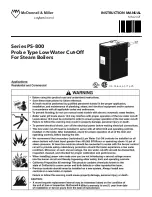
AM Series Boiler & Water Heater User Manual
CHAPTER 4: INSTALLATION
– PIPING
OMM-0100_E
•
GF-146
•
11/15/2019
Technical Support
•
(800) 526-0288
•
Mon-Fri, 8 am - 5 pm EST Page 45 of 170
SECTION 4:
INSTALLATION – PIPING
4.1 Water Inlet and Outlet Piping
When connecting the hot water outlet and cold water inlet to building piping, first make sure the
threads are thoroughly clean. AERCO recommends using Loctite ® 7649 to prime the threads
and then Loctite 567 as pipe dope.
Do NOT use Teflon tape.
4.2 Water Quality
•
Before connecting the boiler to the heating system, the heating system must be
thoroughly flushed to remove sediment, flux, filings and other foreign matter. The heat
exchanger can be damaged by build-up of corrosion due to sediment.
•
An approved inhibitor should be added to the heating system water to prevent limestone
and magnetite deposits from forming and to protect the boiler from galvanic corrosion.
•
The manufacturer cannot be held responsible for any damage caused by incorrect use of
additives in the heating system.
•
Continual fresh make-up water will reduce boiler life. Mineral buildup in the heat
exchanger reduces heat transfer, overheats the stainless steel heat exchanger, and
causes failure. Addition of oxygen carried in by makeup water can cause internal
corrosion in system components. Leaks in boiler or piping must be repaired at once to
prevent makeup water entering the boiler.
•
Do not use the boiler to directly heat swimming pools or spa water.
•
Hardness
–Hardness substantially contributes to the formation of scaling, which is highly
undesirable. The total hardness must be less than 200 ppm total dissolved solids (TDS).
•
Artificial Softness
– Do NOT use artificially softened water. Artificial softening agents
generally use salt, which creates a chloride water chemistry, a major contributor to the
corrosion of the types of metals used in hydronic systems. Elevated salt levels also
contribute to higher conductivity levels, another undesirable characteristic in hydronic
systems.
•
Chloride
– Chlorides are salts resulting from the combination of the gas chlorine with a
metal and are instrumental in accelerating corrosion in the types of metals used in
hydronic systems. Chlorides may be naturally occurring in the water. Concentrations of
chlorides in system water should be less than 150 ppm.
•
Conductivity
– Dissolved metals and minerals increase the conductivity of water and
indicate not only the presence of undesired corrosive agents, but also contribute to the
transfer and migration of ions and charged particles in the water that contribute to fouling
of sensors, valves, and other devices used in the system. Additionally, high conductivity
contributes to galvanic corrosion, in which one metal will preferentially corrode when in
when both are in contact with an electrolyte. conductivity should be less than
3000 μS.
•
pH
– The pH must always be between
6.5
and
8.5
. Values out of this range are
corrosive, causing damage to the heat exchanger and/or heating piping.
4.3 System Piping Methods - Boilers
This boiler is designed to function in a closed loop pressurized system not less than 15 psi (1
bar). A pressure gauge is included to monitor system pressure. Each boiler installation must
have an air elimination device, which will remove air from the system. Install the boiler so the
















































